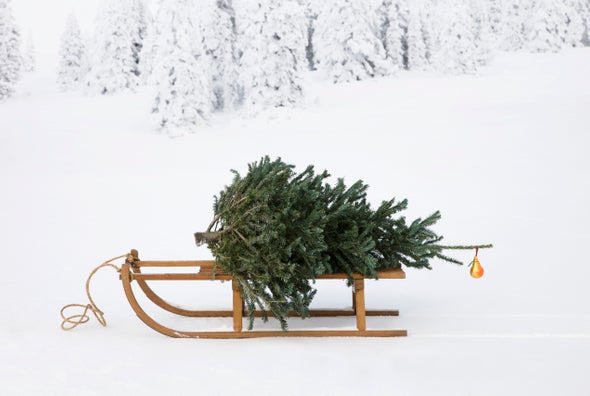(单词翻译:单击)
听力文本
This is Scientific American — 60-Second Science. I'm Christopher Intagliata.
Given much thought to the afterlife of your Christmas tree? Your city might recycle it into compost or mulch. Or it might rot in a landfill, releasing methane, a potent greenhouse gas. But seen through the eyes of a chemical engineer?
"I thought, ok, this could be a good resource." Cynthia Kartey of the University of Sheffield. She says the needles are 85 percent lignocellulose — a tough woody material. But using heat and cheap solvents, Kartey says she can transform pine needles into a liquid product called "bio-oil," which contains glucose, acetic acid, and phenols. Useful stuff.
"Glucose is used as sweetener in the food industry. Acetic acid is mainly used for the manufacture of paint and adhesives. It is also used for the manufacture of vinegar. So basically the vinegar you use in your home is diluted acetic acid. And phenol is used in the manufacture of certain medicines."

Breaking down pine needles also yields a solid byproduct called "bio-char," which Kartey says can be used to drive other chemical reactions. And, although Christmas trees are only available seasonally, she says the same techniques could be used year-round on other agricultural waste, like corn cobs and sugar cane stalks. The goal, she says, is ultimately zero waste.
"It would be an interesting way to decorate your house for Christmas and also get some paint from acetic acid, you could use again to paint your house. To decorate your house once Christmas is over."
Which could give a whole new meaning to 'deck the halls.'
Thanks for listening for Scientific American — 60-Second Science. I'm Christopher Intagliata.
参考译文
这里是科学美国人——60秒科学。我是克里斯托弗·因塔利亚塔。
你有仔细想过你家圣诞树的来生吗?你所在的城市可能会将其回收,制成堆肥或护根。或者圣诞树可能会在垃圾填埋场腐烂,释放强大的温室气体——甲烷。但从化学工程师的角度来看呢?
“我认为,好,这可能是个好资源。”谢菲尔德大学的辛西娅·卡尔蒂说到。她表示,针叶85%的成分都是木质纤维素,这是一种坚硬的木质材料。但卡尔蒂说,利用高温和低价溶剂,她可以将松叶变成一种叫做“生物油”的液体产物,这种“生物油”包含葡萄糖、醋酸和酚类。这些都是有用的东西。
“葡萄糖在食品工业中被用作甜味剂。醋酸主要用于制造油漆和粘合剂。同时也被用来制造食醋。所以,你在家里用的醋基本上就是稀释的醋酸。酚类则被用于制造某些药物。”
分解针叶还会产生一种名为“生物炭”的固体副产品,卡尔蒂称这种物质可以用来催化其他化学反应。她还说,尽管圣诞树的可利用性具有季节性,但同样的技术可在全年用于其他农业废料,比如玉米棒和甘蔗杆。她说,最终目标是零浪费。
“圣诞节期间用圣诞树装饰房屋,节日后用醋酸制造油漆来粉刷房子,这真是有意思的方法。圣诞节结束后就可以装饰房子了。”
这会赋予“装饰大厅”全新的含义。
谢谢大家收听科学美国人——60秒科学。我是克里斯托弗·因塔利亚塔。
译文为可可英语翻译,未经授权请勿转载!
重点讲解
重点讲解:
1. transform into 转换;改变;改造;
The photochemical reactions transform the light into electrical impulses.
光化学反应使光变为电脉冲。
2. break down (使)(物质)分解;
Some washing powders break down proteins by chemical action.
有些洗衣粉能通过化学作用分解蛋白质。
3. year-round 全年的;整整一年的;
They work 7 days a week year-round.
他们一年到头每周工作7天。


